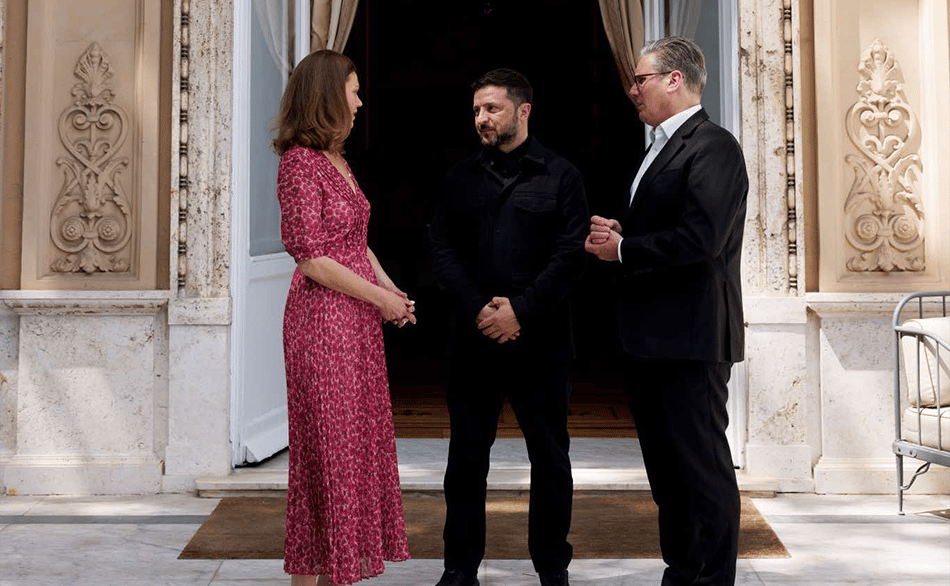Diplomacy in the Eternal City: Starmer, Zelenskyy, and the Quest for Peace in Ukraine
4/27/20253 min read


Diplomacy in the Eternal City: Starmer, Zelenskyy, and the Quest for Peace in Ukraine
On April 26, 2025, the historic city of Rome became more than just the backdrop for Pope Francis’ funeral—it turned into a stage for high-stakes diplomacy. British Prime Minister Keir Starmer and Ukrainian President Volodymyr Zelenskyy met amidst the somber ceremonies in Vatican City, aiming to push forward a "just and lasting peace" in the ongoing Russia-Ukraine conflict. Their meeting, captured in a now-viral X post by Starmer, has sparked global intrigue, heated debates, and a glimmer of hope for a war-weary world. Let’s dive into what this moment means, why it matters, and the challenges that lie ahead.
A Historic Meeting Amidst Mourning
The images shared by Starmer tell a story of urgency and collaboration. In one photo, Starmer, dressed in a sharp black suit, gestures animatedly while speaking with Zelenskyy, who sports his signature dark military-style jacket. The blurred greenery in the background contrasts with the gravity of their conversation. Another image shows them standing with a woman in a red dress—possibly a fellow diplomat—outside the ornate doors of St. Peter’s Basilica, a chandelier gleaming inside, symbolizing the weight of the setting. The funeral of Pope Francis, a pontiff who made peace in Ukraine a cornerstone of his legacy, provided a poignant backdrop for these talks.
Starmer’s post, timestamped at 14:33 UTC on April 26, reads: “Good to see President @ZelenskyyUa in Rome. We discussed positive progress made in recent days to secure a just and lasting peace in Ukraine. We must maintain the momentum.” The message is optimistic, but the replies on X reveal a polarized public. Some users, like @GuntherEagleman, lash out with vitriol, while others, such as @ValentinaForUSA, criticize Starmer for ignoring domestic issues like “Muslim rape gangs” in the UK—a claim often tied to far-right rhetoric. Meanwhile, @NevRhea questions the necessity of Starmer’s trip, pointing out that the Prince of Wales was already representing the UK.
The Bigger Picture: A Diplomatic Push for Peace
This meeting wasn’t a standalone event. Starmer has been deeply involved in Ukraine peace efforts since early 2025. According to POLITICO, he played a key role in brokering a ceasefire plan in March, mending the strained relationship between Zelenskyy and U.S. President Donald Trump after a heated Oval Office clash in February. That ceasefire deal, which Starmer and his national security adviser, Jonathan Powell drafted, restored vital U.S. military aid to Kyiv—a move that bolstered Starmer’s domestic approval, with 37% of British voters viewing him more favorably, per ABC News.
In Rome, Starmer wasn’t alone in engaging Zelenskyy. Reports from CBC News and CNBC confirm that Trump, French President Emmanuel Macron, and other leaders also huddled with the Ukrainian president in St. Peter’s Basilica. These discussions, held in a marble-lined room, aimed to revive faltering peace efforts. The timing is critical: the war, now in its third year, has caused immense suffering, with global ramifications for food and energy security, as noted by Brazilian President Lula in a Wikipedia summary of peace negotiations.
Challenges and Criticism
Despite the optimism, the path to peace is fraught with obstacles. Zelenskyy has consistently demanded that any peace plan respect Ukraine’s territorial integrity, rejecting proposals that cede land to Russia—a stance echoed by Ukrainian Foreign Minister Dmytro Kuleba. On the other hand, Russia’s Foreign Ministry has signaled openness to diplomacy but insists on recognizing its annexations, a non-starter for Kyiv. The Atlantic Council suggests a pragmatic peace might involve European nations like Britain and France enforcing a deal, possibly with troop deployments, but Ukrainians remain wary of international guarantees after the failed 1994 Budapest Memorandum.
Back home, Starmer faces criticism. X users like @JD and @BeeGromit accuse him of neglecting British issues—border security, illegal immigration, and domestic safety—while focusing on Ukraine. Others, like @JohnnyUltimamente, call him a “phony” for shifting from supporting war efforts to inserting himself in the peace process. The use of Pope Francis’ funeral for what some, like @Philthemod, call a “professional photoshoot” has also drawn ire, raising ethical questions about blending diplomacy with mourning.
What’s Next?
The Rome meeting is a step forward, but the road to peace remains uncertain. Starmer’s call to “maintain the momentum” will require navigating a complex web of international interests, domestic pressures, and the unyielding demands of both Ukraine and Russia. As the Atlantic Council notes, a sustainable peace may hinge on Europe stepping up its defense spending and military support for Ukraine, potentially reducing reliance on the U.S. But with public sentiment divided—both in the UK and globally—leaders like Starmer must balance diplomacy abroad with stability at home.
Let’s Reflect
What do you think about Starmer’s role in these peace talks? Can a lasting peace be achieved without one side making significant concessions? How should leaders balance international crises with domestic priorities? Share your thoughts—I’d love to hear your perspective on this pivotal moment in history.
Photo Credit: GettyImage
hello@boncopia.com
+13286036419
© 2025. All rights reserved.